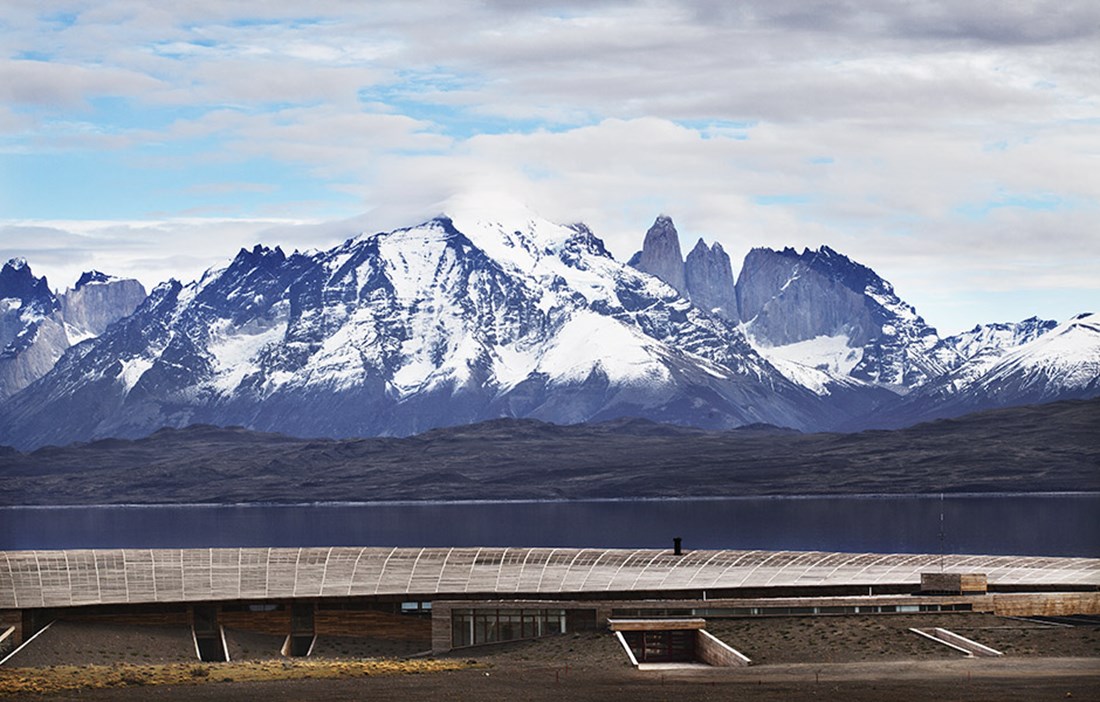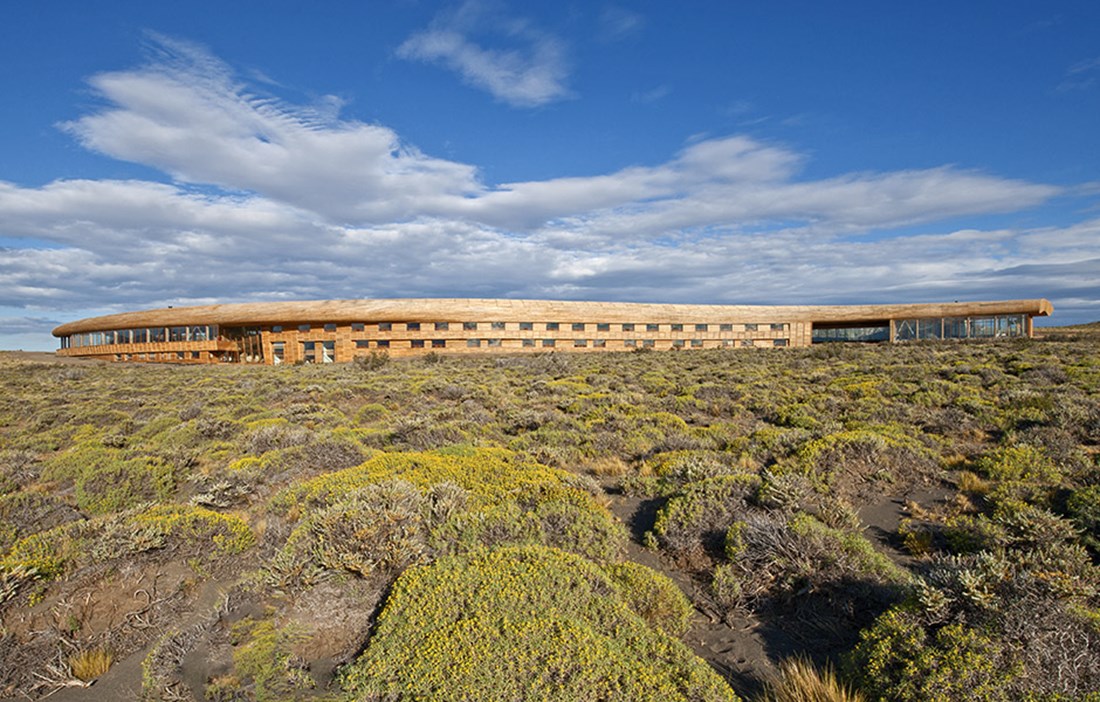PATAGONIA LIES RIGHT at the very southern tip of South America, divided between Chile and Argentina. The terrain here is defined by wide and desolate steppes, beech and pine forests, fjords and some of the world’s largest glaciers – the result of cold air and high levels of precipitation from the western slopes of the Andes. In the midst of this dramatic landscape lies the Torres del Paine National Park and the impressive luxury hotel Tierra Patagonia. The low wooden building crouches on a slope, right where the tundra meets Sarmiento Lake, looking out over the landscape. “Like a fossil, a prehistoric creature, beached by the lake, like something out of Charles Darwin’s drawings” as the hotel’s architect Cazu Zegers puts it. The large hotel melts into its surroundings, forming a soft line in the rugged landscape.
“I love it when people’s first reaction is ‘… so where’s the hotel?’,” says Cazu Zegers.
“When I first secured the commission, it felt like a dream come true, but it was soon followed by a sense of responsibility. It was a major challenge to build a hotel in such an incredibly stunning location without damaging its natural beauty. Without demystifying it.”
Cazu Zegers is an architect with philosophising, almost poetic, ambitions for her work. One day when she was working on the hotel’s interior, she had a vision of the hotel as a whale, specifically the whale that swallowed up Jonah in the Bible.
“I thought about the three days and nights that Jonah spent in the whale, and how that changed his view of the world. In a similar way, I thought it would be great if three nights at the hotel could take guests on a spiritual journey, even if they weren’t aware of it.”
When Cazu Zegers begins a project, she usually starts with one word – something she picks out from the discussion with the client or a feeling she has for the site where the building will be placed. Based on what she calls ‘the poetic word’, she then creates the design. When, together with her colleagues Roberto Benavente and Rodrigo Ferrer, she approached the Tierra Patagonia Hotel, she was inspired by the natural force that is perhaps most striking in the area – the wind – and let that shape the building.
“I like it when buildings have some sort of conversation with the landscape. I therefore borrowed the shape of the hotel from sand that the wind has whipped up into dunes. Just like it does here in Patagonia. The working name for the hotel was even ‘Hotel del Viento’ – the Wind Hotel,” explains Cazu Zegers.
THE HOTEL’S DESIGN takes account of nature, but is also forced to submit to its laws. The building was given a solid concrete foundation and walls, simply to keep it standing on the windswept plain. But the wind was also put to clever use. The building’s sand dune shape follows aerodynamic principles that mean it does not try to resist the wind, instead letting the wind pass over it like on an aircraft wing. This causes the wind to rise and miss the hotel, landing further away beyond the end of the building. The orientation of the hotel means that a warm zone is thus formed at the hotel’s entrance.
Both the exterior and interior of the hotel are clad entirely in lenga wood from southern Patagonia. Different finishes are used in different parts of the building – forming contrasts and harmonies between the different sections of the hotel. The ceiling, for example, is made up of laminated lenga, while the facade has a more rustic, untreated quality.
“The strong winds in the area and the weathering of materials are always an issue when building something here in Torres del Paine. But we still chose to leave the outside of the hotel untreated and let its colour change naturally. The wood will take on a platinum grey hue over time,” says Cazu Zegers.
“However, because of the weathering issue, my client wanted the windows to be PVC rather than wood. This means that there will eventually be a contrast between the windows and the facade, which I think is a bit of a shame.”
LENGA WAS CHOSEN for its tough and hard-wearing properties. The material is well able to cope with the major stresses that the hotel is exposed to on the tundra, but the wood was also chosen for its aesthetic qualities. Walls and ceilings clad in lenga are attractive to the eye. The same is true of the knotty, sunbleached boughs and curved beams in the ceiling and balustrades. The soft wooden floors invite barefoot exploration. At the same time, the interiors are designed so as not to pull focus from the incredible landscape outside the hotel. Well worth a closer look are the features that follow a Chilean aesthetic of streamlined design and simple furniture. Cazu Zegers worked with designers Alexandra Edwards and Carolina del Piano to try and link together nature and the hotel environment by using shapes and materials from the local surroundings. Lamps, balustrades, hooks, rugs and other items are made by Chilean craftsmen in local materials such as wood, leather and wool. Together they form a relaxed and luxurious environment without being too showy.
Using wood so extensively was not without its problems. Fire, for example, was something that had to be given serious consideration due to the major risk of fires on the plains at certain times of year.
“All the walls are concrete. Only the roof is made entirely of wood. We have installed a sprinkler system and smoke detectors. There is also a water tank outside the building that can be used to fight fires. But you have to be aware that when the big fires come across the pampas, you can only pray to be spared. The strong winds make fires particularly difficult to deal with.”
Sound insulation was also an important consideration. The solution was for the hotel room walls to be made of triple plasterboard panels on a metal frame, complemented with mineral wool. The doors to each room were made thick and heavy. Extensive acoustic tests were then carried out in the hotel to check the sound insulation.
With its 40 rooms and spa facilities, Tierra Patagonia Hotel is a popular holiday destination. Included are guest transfers from the airport in Punta Arenas or Puerto Natales, both an hour’s drive from the hotel. The distance from civilisation is one of the hotel’s blessings, enabling outdoor enthusiasts to get deep into the wilderness direct from the hotel entrance. However, when the hotel was being built, it was more of a curse.
“The greatest challenge for the workers on the project was the hotel’s inaccessibility and extreme weather conditions. Sometimes we had 300 construction workers here at the same time and they had to live in the temporary camp we set up. And then there was the issue of getting all the construction materials to the site. A lot of it came from Santiago but was transported via Argentina, because there are no Chilean roads all the way here.”
After 13 months of work, the hotel was finally completed. And Cazu Zegers is pleased.
“This was my first building of this size, and I think it turned out really well! I’m also pleased and proud to be part of a Chilean architectural tradition of designing buildings that merge into the stunning landscapes we have here. Buildings that don’t try to take attention away from nature, because they’ll never succeed. In Chile, competing with nature is an impossibility.”
Text Erik Bredhe























